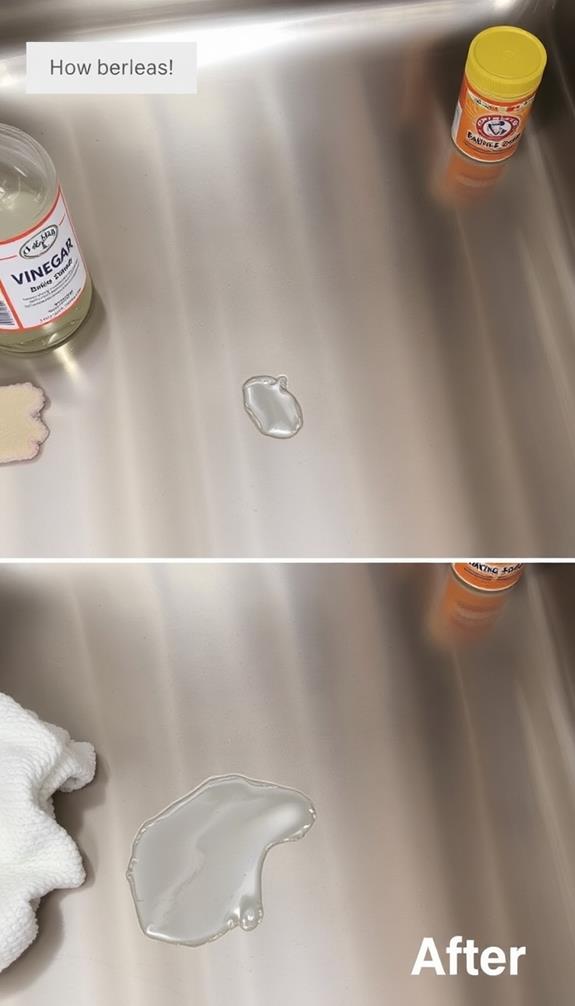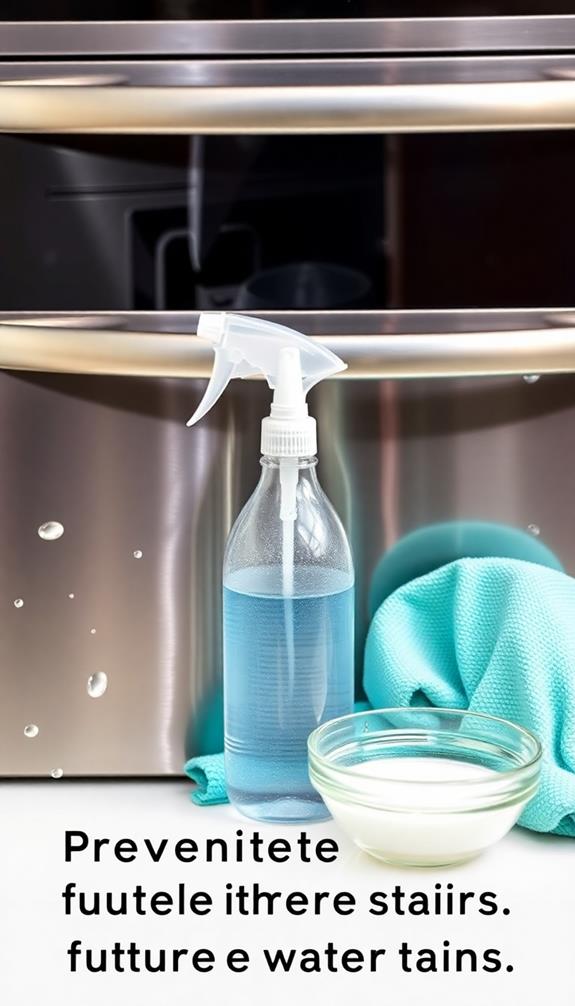Removing water stains from stainless steel is easy and takes just a few steps. First, mix equal parts white vinegar and water in a spray bottle. Spray it on the stains and let it sit for a few minutes. Use a microfiber cloth to gently scrub the area, then rinse with clean water. For stubborn stains, create a paste with baking soda and water, apply it, and follow with a vinegar spray for extra lifting power. Finally, buff the surface with olive oil for shine and protection. Stick around to discover more tips on maintaining that sparkling clean look!
Required Materials
To effectively tackle water stains on stainless steel, you'll need a few key materials. First, grab some white vinegar, as its acidic properties work wonders in breaking down tough stains and mineral deposits.
Vinegar also acts as an antimicrobial agent, helping to disinfect and shine surfaces, making it a versatile cleaning solution for your stainless steel appliances. You'll also want to have water on hand for dilution and rinsing.
A soft microfiber cloth is essential for gently cleaning and drying your stainless steel surfaces without scratching them. Additionally, consider having baking soda ready. When mixed with water, it forms a heavy-duty cleaning paste that's perfect for those stubborn stains that just won't budge.
For more effective cleaning methods, check out natural cleaning agents that can enhance your routine.
If you're dealing with mineral deposits, club soda can be a game-changer. Its carbonation helps lift those pesky deposits off the surface, making cleaning easier.
Application Steps
Start by preparing your cleaning solution for those stubborn water stains. For a highly effective approach, consider using a mixture of vinegar and water for an eco-friendly cleaning option.
Fold a paper towel into fourths for controlled application. Next, take a quarter-sized amount of olive oil and apply it with the grain of the stainless steel. Move left to right to guarantee even distribution across the surface. This will help remove water stains and any hard water spots that have settled in, enhancing the overall appearance of your stainless steel with proper application techniques.
After applying the olive oil, wipe away any excess with the paper towel. This step is vital to prevent buildup and make sure you have a clean surface.
Then, grab a clean microfiber cloth to buff the surface. This not only enhances the shine but also removes any remaining residue from the oil, leaving your stainless steel looking polished.
Regularly buffing the surface will help maintain its appearance and prevent dullness over time. By following these application steps, you'll keep your stainless steel free from stains and looking its best.
With just a little effort, you can easily remove water stains and enjoy a sparkling clean finish.
User Feedback and Tips

Many users have found that incorporating regular buffing into their cleaning routine really pays off when it comes to maintaining stainless steel. This simple step not only helps you remove water stains on stainless surfaces but also prevents buildup and dullness over time.
Regular maintenance extends the lifespan of appliances and helps keep them looking pristine. Many recommend using vinegar for cleaning stubborn hard water stains and mineral deposits in places like drip trays; its effectiveness is hard to beat.
If you're dealing with tough stains, combining baking soda with vinegar creates a powerful reaction that can tackle those stubborn marks. Users report great success when applying this mixture to affected areas.
Additionally, consistent use of olive oil as a final buffing step can dramatically enhance the appearance of your appliances. While some have inquired about using alternative oils, olive oil is often favored for its effectiveness and non-staining properties.
Lastly, investing in a quality stainless steel cleaner can also help you maintain stainless steel surfaces.
Additional Cleaning Techniques
When it comes to tackling water stains on stainless steel, several effective cleaning techniques can make a significant difference.
Start by using vinegar, which is great for hard water stains and is a non-toxic cleaner that safeguards your family's health. Mix equal parts vinegar and water in a spray bottle, spray it on the stains, let it sit for 5-10 minutes, and then scrub gently with a microfiber cloth.
If you're dealing with tough stains, consider using baking soda. Create a paste with baking soda and water, apply it directly to the stains, and then spray with vinegar for a foaming action before scrubbing.
You can also harness the power of lemon juice. Just rub a cut lemon on the stains, let the juice sit for a bit, and then scrub with a microfiber cloth.
Another option is club soda; pour it directly onto the stains, letting the carbonation lift mineral deposits, followed by a thorough scrub.
Preventing Future Stains

To keep your stainless steel surfaces looking pristine and free from water stains, implementing preventive measures is key. Start by regularly wiping down your stainless steel after it comes into contact with water. Use a soft cloth to prevent mineral buildup from hard water, which can lead to unsightly stains.
When cleaning, opt for a mild detergent to minimize the chances of mineral deposits forming on the surface. For deeper cleaning and effective germ removal, consider using a quality disinfectant like Clorox Free & Clear Multi-Surface Spray Cleaner, which is scent-free and EPA-certified.
Always remember to dry your stainless steel immediately after cleaning or exposure to water. This simple step can greatly reduce the risk of new stains developing.
Additionally, consider installing a water softener in your home. This can dramatically lower the mineral content in your water, making it easier to maintain your stainless steel surfaces and preventing hard water stains.
Establishing a routine maintenance schedule for cleaning your appliances can help catch any potential staining early. By staying proactive, you reduce the likelihood of stubborn buildup.
With these strategies in place, you'll effectively be preventing future stains, keeping your stainless steel looking sleek and shiny for years to come.
Conclusion
With just a few simple steps, you can banish those pesky water stains from your stainless steel surfaces, restoring their shine like a beacon in the night. Remember, a little prevention goes a long way—treat your stainless steel with care, and it'll reward you with a glimmering finish. So, roll up your sleeves, grab your materials, and let your efforts transform dullness into brilliance. Your stainless steel will thank you with a sparkle that lights up any room!